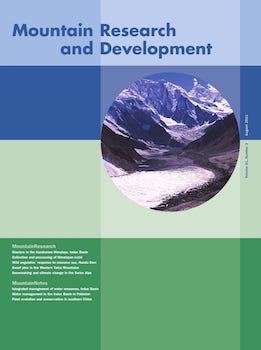Dear Readers,
Three papers in the present issue of MRD focus on water resources in a single watershed, the Indus Basin. This is one of the largest watersheds in the world and provides a significant example of the importance of understanding highland–lowland interactions for improving water management. Indeed, well over 200 million people in the lower basin depend on the water that originates from headwaters shared by China, India, Pakistan, and Afghanistan. This issue of MRD opens with an overview of Karakoram Himalayan glacier dynamics by well-known glaciologist Kenneth Hewitt. This paper is likely to be of great use to colleagues engaged in understanding the complex dynamics of glacier replenishment in the remote Upper Indus Basin; it revisits classifications of glaciers based on a thorough state-of-the art and years of work focusing on glacier dynamics. Hewitt first presented his results on the occasion of an international multistakeholder expert consultation convened by the International Centre for Integrated Mountain Development (ICIMOD) in July 2010. The second paper on the Indus Basin is found in the MountainNotes section. It is authored by Madhav Karki, Arun Bhakta Shrestha, and Mathias Winiger, and explains the rationale for this consultation, as well as the purpose of the related Integrated River Basin Management initiative launched as a common effort of the concerned states. The third Indus Basin paper, also found in the MountainNotes section, is by another acknowledged expert, Asad Sarwar Qureshi; it presents the state-of-the-art on water resources, water policy, and water management in Pakistan, and offers policy recommendations for improving understanding and management of the Indus Basin's water resources in this country. These 3 papers will be followed by additional Indus Basin work in upcoming issues of MRD, by authors who were also part of the multistakeholder consultation.
Further papers in the MountainResearch section focus on other natural resources in mountains around the world, on their dynamics, and on the impact of human use and needs on these resources. Thus, Sanjay Kr. Uniyal and colleagues analyse local people's patterns of collection and processing of a medicinal plant for commercial purposes in the Western Himalaya, and describe conservation threats. Tapajit Bhattacharya and Sambandam Sathyakumar focus on the response of mostly rare wild ungulates to use of pastures in the Nanda Devi Biosphere Reserve, India. Juraj Švajda and coauthors offer their analysis of dwarf pine—a timberline species in the Western Tatra Mountains—as a baseline in the underresearched Carpathians for further work on this species, which can serve as an indicator of different environmental changes, especially climate change. Finally, Christian Rixen and colleagues present an assessment of resource consumption, snow reliability, and future snow-making potential in Swiss Alpine winter resorts already affected by climate change. This is the first part of a two-part study on snowmaking and tourism in Switzerland, the second of which will be published in the next issue of MRD.
A further paper in the MountainNotes section is an interesting review of the state-of-the-art in botany focusing on evolutionary aspects of plants in protected areas in the biodiversity-rich mountains of Southern China. Jordi López-Pujol and his Chinese coauthors conclude their paper by presenting an agenda to deal with the conservation of endemic plants.
In the MountainPlatform section, Andreas Schild (ICIMOD Director) and Eklabya Sharma (MRD International Editorial Board member) revisit the agenda for sustainable mountain development: what happened since the loosely called “Mountain Agenda” group initiated Chapter 13 of Agenda 21 and the adoption of numerous mountain initiatives worldwide? The authors assess what progress has been achieved from their perspective and suggest what needs to be done in Rio de Janeiro next year, at the “Rio+20” United Nations Conference on Sustainable Development (4–6 June 2012).
We are convinced that readers will find ample food for thought on important mountain resources and processes in this issue of MRD, and look forward to possible responses.





